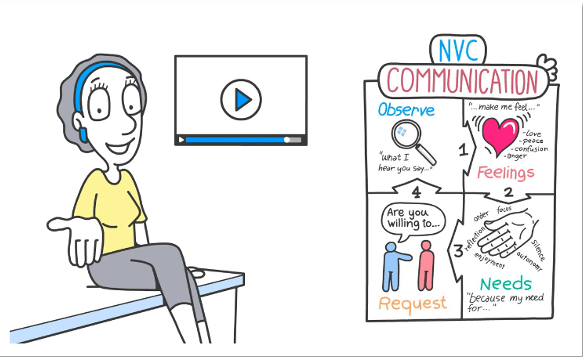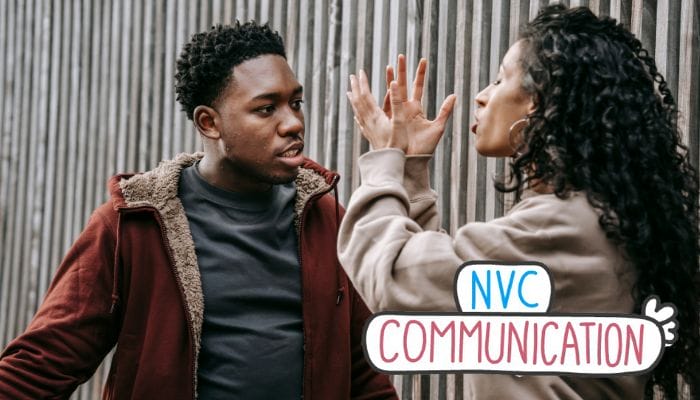One reason I spend so much time with nonviolent communication is that I believe it can have a profound impact on my life. Several times a week, my head is boiling when I come into a situation where I think the person, I speak with is an idiot. Sure, people like the author of Surrounded by Idiots, Thomas Erikson, may say that it’s probably me who is the problem. But, I’d never accept that.
So, what can NVC do for me in these situations? How can NVC help when you think someone is an idiot?
Let’s look at one of these times:
Background:
My girlfriend had bought paintings, and she wanted to put frames around them. The frames came in parts, and we needed to put them together. To do that, we needed to use 3 different kinds of glue. The place we decided to do that was by the living room table. (I know, we should have done it somewhere else, but that’s where she chose, and I didn’t want to pick a fight directly.)
The trigger for my reaction came when she sat on the sofa and tried to glue things together without covering the sofa. When I said we needed to put something under her to protect the sofa, she got annoyed and said that she was careful and nothing would happen.
I know this was perhaps not the biggest thing to be angry about but to be fair, these things happen all the time. I became furious. I didn’t say anything, instead, I went to the bedroom to try to analyze, what happened in my head. This blog post is a result of that. The following thoughts cross my mind:
- She is a gigantic baby*
- Hopeless idiot
- Understands nothing
- It’s not her sofa
- She thinks it’s annoying to be proactive
- SHE HAS the audacity to get annoyed
- She is irresponsible
- She is careless
- She is clumsy
- She has no sense of consequence analysis
- She has to make the mistake before she can learn from it
As you can see, A LOT of judgments went through my head. I guess this is what happens every time I encounter an idiot. I’d like to know what happens to me, to see if I can learn something from it. By understanding my own reaction and empathizing with my feelings and needs, I might be able to handle these situations better.
Let’s look at the observations I made and had made earlier that day.
Observations:
- She sat on the sofa (new sofa) while handling glue, and a glue stain would be impossible to remove.
- Earlier the same day, she had opened a yogurt box on the sofa and spilled yogurt on the carpet between the sofa and the table. (The yogurt hit her hand instead of landing on the sofa)
- We were doing something none of us had done before. (working with different kinds of glue and frames.)
Notice that I started by listing my thoughts on the situation. I wanted to know exactly what I was thinking instead of trying to analyze it. Somehow, only listing these made me calm down. Making objective observations is difficult when strong emotions are involved, but starting with our thoughts gives us a few minutes to relax.
Next, I listed my feelings.
- I feel frustrated because people don’t understand (this is a feeling, but as you can see, I blamed it on the other person instead of taking responsibility for it)
- I’m angry
- I feel tired and despondent
- I’m annoyed and irritated
- I’m disappointed
- I feel impatient
- It doesn’t feel fair. (Somehow, it felt unfair, but I couldn’t really put words on it)
You know what comes next. What needs did I have in the situation?
- I want to take care of my things; I need respect for my things
- I need to be heard and understood.
- I want my stuff to stay beautiful (undamaged) for as long as possible
- I need people to show consideration for my stuff
- I want us to be a team and collaborate.
*
What is behind the thought that she is a gigantic baby?
I want to feel like an equal. I want us to be on the same level when it comes to taking responsibility and competence—to be grown-ups.
Analysis:
Since these situations arise weekly, I wanted to really understand what was happening to me. I began to list my thoughts, observations, feelings, and needs.
Just listing these things helps me better understand what is happening. Sometimes, that’s enough to calm down.

However, I’d like to know more.
What need was the most important to me in this situation?
When I looked at all the needs, they all came down to one main need.

Understanding this was very satisfying! I get so angry in situations where I think the other person is an idiot because my need for being heard and understood is not met.
How could I get this need met in these kinds of situations?
I must accept that this need is not being met in some situations, and I can do little about it. By understanding why I react as I do, I can give myself the empathy to keep calm in the situation. It could, for instance, be with a person you only meet once in a shop. In this situation, it’s not worth the effort to tell the other person what is happening to you and try to get this person to do what you want to meet your needs.
BUT!
When it comes to people I meet often or have a relationship with, I need to find a way to satisfy my need for being heard and understood.
In NVC, we have two ways to create the connection we need to get what we need.
- To express honestly what we need
- Begin by listening with empathy
Learning about Nonviolent Communication can be frustrating, but once we gain a small understanding of what happens around us, it’s truly amazing! This post is part of our Nonviolent Communication Video Course. Here is a link to the Course page if you want to learn more. Don’t miss the opportunity to learn nonviolent communication truly. It can help you in so many areas of your life.

 English
English Español
Español Français
Français Português
Português Svenska
Svenska